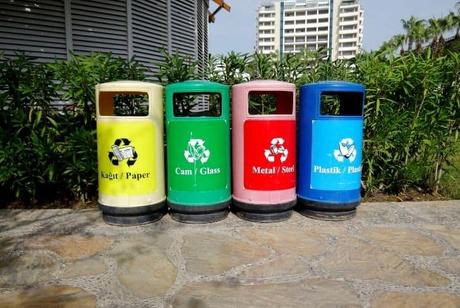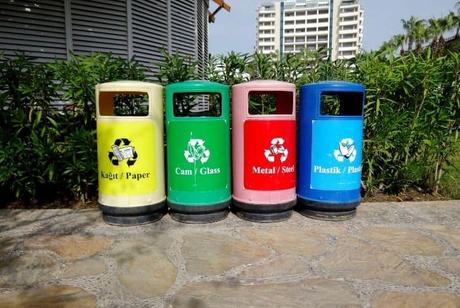Can You Put Wood in The Recycle Bin?
Considering that paper is recyclable and paper comes from trees, you would think that wood is also recyclable. But before you start putting the lumber or yard waste in the recycling bin, let’s understand whether or not you can put wood in the recycling bin.

Is It Okay to Put Wood in the Recycling Bin?
Wood cannot be recycled through your curbside recycling. While the paper is derived from wood and the former is safe to recycle; generally, recycling centers are not yet equipped with the technology to handle wood.
The majority of recycling only takes household items such as plastics, mixed papers, etc. Once the garbage is picked from the home, it is taken to the sorting center, where materials are separated from each other. And, these sorting centers are capable of handling wood.
Another issue with wood is that they are finished or treated. So even the sorting center can handle wood, it would be challenging to properly sort out the finishes or treated wood. This is not safe to move through the recycling process.
Can You Put Wood In The Garbage?
Most of the wood that you get is treated or finished, and the recycling centers have a hard time processing these types of wood. This is why it is not recommended that you put the wood in the garbage.
Is Wood Recyclable or Garbage?
Other than the fact that recyclable facilities are not prepared to treat wood, treated wood is also hazardous. The wood, when used for various purposes, are treated to look and work a certain way. This reduces their ability to decompose in a healthy manner. This is why it is important to differentiate the kind of wood which cannot be used for recycling.
Following are the type of wood that should not be recycled:
1. Treated Wood
Never put treated wood into the recycling bin. This is because these types of wood are chemical and are not suitable for making new products out of it. The chemicals in the wood pieces can seep into the surrounding area and may pose extreme health hazards.
2. Painted Wood
It is another form of wood that you cannot put into the recycling bin. The paint has harmful chemicals, and this will also impact the strength of the adhesion.
3. Lacquered Wood
You should never put lacquered wood into the recycling bin. Wood, which is treated with lacquer on the outer layer, impacts the ability of the wood to stick to other wooden pieces. In the recycling process, it will separate and stick to all other wood pieces. And in case it is not able to stick, then there might be a problem.
7 Alternative Ways To Dispose of Wood
Since it is not recommended to put the wood into a recyclable bin, there are some safer and efficient ways that you can treat the waster wood. Some of the alternative ways to dispose of wood include-
1. Use It To Create Mulch
One of the best ways to dispose of old wood is to create mulch, which can be used in the garden. Mulch is a great way to improve the overall health of your garden plants. There are many benefits of using wood mulch on the plants that include –
- It improves the quality of the solid by segregating the clay and enabling the movement of water and air through the soil.
- Mulch can help your plants survive during the drought period as it controls the water quantity being evaporated from the soil/
- It reduces the growth of weed, and the weed that ends up growing is easier to pull out.
- It acts as a layer of insulation on the top, maintaining coolness in the summer.
But when making mulch, make sure you use untreated wood.
2. Reuse it
One of the best ways to reuse old wood is to reuse it. Wood is referred to as building material for a specific reason, and that is because it is an excellent source for building different structures. Wood is considered perfect for building different decorative structures in the garden, and you can also use it to make furniture.
Treated wood like railroad ties and utility poles are especially good for repurposing. Pieces of wood can be used to construct fences, bridges, barriers, etc. They can be used in order to control erosion. However, there might be a risk of water contamination.
3. Use It As Compost
If you have some untreated wood, then you can use it as compost. Wood is a substance rich in carbon; therefore, it can be a perfect addition to material rich in nitrogen. Wood would act as a filler that will wick up the water from the water, improving the composting process. It is important that you avoid using treated wood as it can impact the overall health of your plant and hinder the qualities of other materials in the composite.
4. Use It In The Fire Pit
Considering that you have the approval from the local ordinances, you can add the wood into your fire pit. Purchasing wood can be expensive, and this proves to be a perfect way to utilize your unused wood. It is recommended to use natural wood in the fire pit. This means that the wood should not be painted, stained, or treated in any other form.
5. Sell The Unused Wood
Wood is among the prominent building materials. Therefore, they are always in demand. So instead of just throwing the unused wood away and making a few bucks. Besides, when you are selling it, you do not have to worry about whether the wood is natural or treated.
You will get a good amount for any type of wood. Moreover, if you are not able to find a buyer or do not want to go through the listing process, you can simply give it away to your friends, family, or neighbors who might need it.
6. Submit It To Hazardous Facility
We understand that most of the alternative solutions were for natural wood, so what to do with treated wood? The option is to take the treated wood to the hazardous waste facility. You can give the wood to the facility for a small fee. In fact, in some facilities, you do not even have to pay from residents, but if you are a business owner, then you might be charged.
7. Sent It To Biomass To Energy Producer
Another option to put the wood to use is to take it to the biomass-to-energy producer. They can use the material to produce electricity or steam using the wood. While combustion of fuel results in emission, burning wood is relatively cleaner than the majority of fossil fuels.
How Can You Use Wood Ash?
The wood that you would use in the fire pit can even be useful after being burned down. Wood ash is enriched with potassium and is considered an important nutrient for trees, plants, and shrubs. It assists in regulating water in the plant cells, the growth of starch and sugar in the plants, and the transportation of food. And if the growing plants do not get potassium in an adequate amount from the soil, they become vulnerable to pests, diseases, frost, and drought.
1. Good For Mulch
If you want to make sure that soil stays moisturized and weeds do not surface around the plant, you can use the mulch. It gradually releases the required nutrients into the soil. You can add wood ash to the mulch that you use in the garden plants. However, do not use wood ash on plants that grow in acidic spills such as blueberries and raspberries.
2. Effective Lime Substitute
In case you want the garden soil to be more alkaline, you can use wood ash rather than lime. However, the quantity of alkalinity the ash will cause will differ. Moreover, hardwoods contain more nutrients as opposed to softwood.
Therefore, based on the type of wood you have burned, you can increase the pH level of the soil. Moreover, ensure to check the potassium content of the soil before you add ash in place of lime. Potassium in excessive amounts can impact the ability of plants to absorb nutrients.
3. No Pests Issue
One of the benefits of using wood ash in your garden is that you can get rid of issues with pests. Gardeners would know how much damage snails, slugs, and other types of pests can do to your lovely plants.
One of the cost-effective and easy ways to get rid of pest issues in your garden is by sprinkling some wood on the soil. Snake sure that the mask does not get wet because it will diminish its ability to deter pests. This has been a tried and tested method to get rid of pests in the garden and keep your plants looking lovely.
Final Thoughts
Although it is not safe or recommended to recycle wood along with other recyclable items of the house in the curbside pickup, there are options to recycle it. And if that option does not work for you, there are alternative options to reuse or dispose of the wood and put it to better use.


